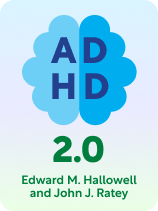

This article is an excerpt from the Shortform book guide to "ADHD 2.0" by John Ratey and Edward Hallowell. Shortform has the world's best summaries and analyses of books you should be reading.
Like this article? Sign up for a free trial here.
Do you live with ADHD or know someone who does? Are you looking for ways to maximize the pros and minimize the cons of ADHD?
ADHD 2.0, a book by Edward Hallowell and John Ratey, explores recent developments in the field of psychiatry to help people understand this condition and learn to manage their symptoms. It also shows them how to turn ADHD’s unique traits to their advantage.
Continue reading for our comprehensive ADHD 2.0 book overview.
ADHD 2.0 Book Overview
Do you know someone whose mind seems to wander constantly? Maybe they often seem to be distracted, tired, or bored. They may struggle in social situations, coming off as rude and self-absorbed. They never seem to live up to their potential, and it seems like if they’d just try a bit harder, they could accomplish great things. Perhaps this even describes you.
That person may be struggling with Attention Deficit Hyperactivity Disorder (ADHD), a neurological condition that’s estimated to occur in 5% to 10% of the world’s population. The most obvious signs of it are an inability to concentrate, a lack of motivation, and trouble sitting still without squirming or fidgeting. ADHD 2.0, a book by Edward Hallowell and John Ratey, explains what causes this condition and what it’s like to live with it. The authors make the case that people can succeed and thrive because of—not in spite of—having ADHD.
(Shortform note: The authors may provide the range of 5% to 10% rather than a specific estimate for the prevalence of ADHD because it’s hard to determine exactly how common the condition is. ADHD is hard to diagnose reliably; for example, one study suggests that the condition is underdiagnosed in adults, while another concludes that it’s overdiagnosed in children and teens.)
Hallowell is a psychiatrist specializing in ADHD and the founder of the Hallowell ADHD Centers—facilities that offer diagnostic and treatment services for ADHD and related conditions. Ratey is an associate clinical professor of psychiatry at Harvard Medical School. Both authors have ADHD, allowing them to add personal insights to their professional training.
Hallowell and Ratey coauthored the Distraction series of books. Starting with Driven to Distraction (published in 1992), these books explore ADHD not as a disorder, but simply as a different way of thinking—one that has its own strengths and advantages. ADHD 2.0, published in 2021, describes ADHD’s biological causes and its most prominent symptoms. It also explores various ways to minimize ADHD’s downsides and maximize its benefits, such as finding the right kind of challenge to stay engaged and building a strong support network.
(Shortform note: ADHD, like most psychological conditions, can present in numerous different ways and with different degrees of severity. The authors—and this guide—discuss traits, symptoms, strengths, and challenges that people with ADHD tend to have or encounter; not every person with the condition will have these exact experiences.)
Causes, Challenges, Strengths, and Symptoms of ADHD
First, we’ll provide some foundational information about ADHD. We’ll start by describing the neurological causes of this condition, as well as some of the most common challenges that people with ADHD face. Then, we’ll move on to discussing what people with ADHD tend to excel at. Finally, we’ll explain some of the common signs and symptoms of ADHD to help you recognize it in yourself or others.
The Neurology of ADHD
Hallowell and Ratey begin by explaining that ADHD results from having a brain that works differently from those of neurotypical people. (Neurotypical means the type of brain that the majority of people have—in other words, having no psychological disorders.)
First, the cerebellum is underdeveloped in people with ADHD. This part of the brain is responsible for things like learning new skills, regulating emotions, and making quick decisions, as well as physical balance and coordination.
The other major difference is a deficiency of certain neurotransmitters: molecules that carry signals to brain cells, muscles, and other parts of the body. The most notable deficiencies in people with ADHD are in dopamine (associated with motivation) and norepinephrine (associated with concentration).
The authors add that, recently, many people without these neurological differences are showing symptoms that mimic ADHD. They call this VAST: variable attention stimulus trait. VAST occurs because modern society bombards people with constant stimulation and data from smartphones, social media, and the like. We receive too much information, and it comes too fast for the brain to process. ADHD-like traits, such as the inability to focus on the present moment and the compulsive need to check a smartphone every few minutes, are the brain’s attempts to keep up with that deluge of data.
ADHD Challenges
The authors describe a few of the most common challenges that people with ADHD face in everyday life:
1) People with ADHD are inattentive. They often have trouble staying on task. They get bored easily, yet they find boredom unbearable, so their chronically understimulated minds wander in search of something interesting to think about. This mental restlessness often manifests as physical restlessness, especially in men—they bounce their legs, drum their fingers, and so on.
2) People with ADHD are impulsive. They tend to make hasty decisions without thinking them through first. They also struggle with delayed gratification—in other words, resisting an immediate temptation for a better reward later. For example, someone with ADHD might miss an event they wanted to go to because they stayed up all night playing video games; the promise of having fun the next day carried less weight than the immediate pleasure of gaming.
3) People with ADHD struggle with time management. The authors say that many people with ADHD only experience time in terms of “in the present” and “not in the present.” For example, if they have an important meeting coming up in an hour, that means the meeting is “not in the present”—therefore, they won’t think about it. As a result, they might fail to get ready or may show up late. Similarly, when tackling a long-term project (in other words, one that’s due “not in the present”), people with ADHD will often put it off until the last possible minute.
4) People with ADHD are forgetful. Specifically, they struggle with working memory—short-term memory associated with making decisions and accomplishing tasks. Their minds are so busy and racing so quickly that they sometimes forget what happened just moments ago. For example, someone who goes into the kitchen intending to do the dishes might get distracted by junk food, have a snack, and then leave without doing the dishes.
TPN and DMN
Halloway and Ratey further explain that a lot of the challenges of ADHD come from an inability to shift between two types of brain activity: activity in the task-positive network (TPN) and in the default-mode network (DMN).
Activity in the TPN happens when someone’s absorbed in a task. They concentrate on that single thing to get it done. This state is often called flow or “being in the zone.” In contrast, activity in the DMN puts the person into a thoughtful, imaginative state. It enables them to think about past experiences, plan for the future, and come up with new ideas.
In neurotypical people, these two types of brain activity work one at a time. They switch as needed so the person can come up with ideas and then carry them out or retreat into a daydream for a few minutes to take a quick rest.
However, in people with ADHD, the DMN and TPN are often active at the same time. This means that, even when the person’s trying to focus on a task, their imagination is running wild.
ADHD Strengths
The authors describe ADHD as a condition of opposite extremes—for every exceptional challenge that people with ADHD face, they have an exceptional strength to balance it. Here, we’ll highlight four examples of strengths:
1) People with ADHD can hyperfocus. A condition characterized by a lack of focus also comes with a tendency to focus so intensely on something that the rest of the world might as well not exist.
Hyperfocus is how people with ADHD can put off large projects until the last minute and then do a week’s worth of work in a day—that’s why it’s sometimes referred to as the “ADHD superpower.” Hyperfocus also explains why a child with ADHD who can’t sit still for a single class period can get lost in a video game or book for hours on end.
2) People with ADHD are energetic. The fidgety restlessness that’s so common with ADHD can become a seemingly inexhaustible supply of energy when there’s an interesting task to put that energy toward. For example, a “poor” student who can’t sit still in class might be their school’s star athlete.
3) People with ADHD are emotional. This is both a challenge and a strength. People with ADHD are prone to intense anger, frustration, and sadness. However, they can also be highly empathetic, extremely cheerful, and fiercely devoted to their loved ones.
4) People with ADHD are highly creative. Their racing thoughts, along with their tendency to connect apparently unrelated concepts, mean that people with ADHD are extremely good at coming up with innovative new ideas.
Signs of ADHD
We’ve discussed the strengths and weaknesses of ADHD; if they sound familiar, you might now be wondering whether you or someone you know has it. Hallowell and Ratey clarify that only a mental health professional can diagnose ADHD, but they describe three of its most common signs:
1) Racing, uncontrollable thoughts. People with ADHD have extremely quick minds, coupled with difficulty controlling or directing their thoughts. In other words, their thoughts move much faster than other people’s, but not always in useful ways—they often get stuck in cycles of uncomfortable, anxious, or brooding thoughts.
2) Underachievement. People with ADHD frequently fall short of what others expect them to achieve. Parents, teachers, and bosses often mistakenly blame such underachievement on a lack of effort or interest. For example, a smart student who consistently underperforms in certain subjects may be struggling with undiagnosed ADHD.
3) General dissatisfaction. People with ADHD often feel that normal, everyday life isn’t “enough”—exciting enough, interesting enough, fulfilling enough, and so on. As a result, they look for ways to enhance or intensify their lives. Sometimes this results in incredible achievements, but it may also result in addiction or dangerous, thrill-seeking behavior.
Now that we’ve briefly explained what ADHD is, we’ll devote the rest of this guide to explaining how to thrive with this condition. First, we’ll discuss the importance of finding the right kind of challenge to keep an ADHD brain engaged. Next, we’ll explain why social connections are important—and, often, difficult—for people with ADHD. Finally, we’ll explore some strategies for creating an ADHD-friendly lifestyle.
People With ADHD Thrive When Challenged
We’ve explained some strengths and weaknesses that come with ADHD. In this section, we’ll explore how to take advantage of the strengths to accomplish great things.
Hallowell and Ratey note that people with ADHD love a good challenge. Faced with a difficult problem, people with ADHD can enter hyperfocus and often become more productive than their neurotypical peers.
However, it has to be the right kind of challenge: something that engages their interest as well as pushes their limits. For instance, moving heavy rocks might be challenging, but it isn’t interesting—unless they first have to figure out how to move the rocks, which allows them to exercise their natural creativity.
Tip: Leverage Natural Interests
The authors say that people with ADHD often have a couple of things they’re exceptionally good at or extremely passionate about. These things naturally hold their interest and therefore can be the key to making the most of their ADHD strengths.
For adults with ADHD, finding a job that involves these interests is crucial to their happiness, their sense of fulfillment, and often their financial stability. Their success or failure has less to do with how difficult the job is than with how well it holds their attention. They might find a simple but boring job far more difficult than a complicated but interesting one.
For children with ADHD, the same principle holds true: They’ll do much better in school if the schoolwork leverages their natural interests. For example, a child with a natural interest in music might find math more interesting if someone explains how much math is involved in music—time signatures, beats and rhythms, how musical notes represent fractions of a measure, and so on.
However, some people may not even realize what their natural interests are. In that case, the authors suggest they make a list of everything they’re good at and everything they love doing—in particular, they should write down anything they find easy that other people seem to struggle with. That list can become a guide to finding jobs they’ll enjoy and excel at.
People With ADHD Need Connection
We’ve discussed the importance of meeting the intellectual needs of people with ADHD; now, we’ll move on to discussing their social and emotional needs. Halloway and Latey say that people with ADHD have a deep-seated need for interpersonal connection—in other words, for love.
The authors emphasize the importance of connection for several reasons. First, people with ADHD often struggle in social situations, which makes it more important for them to nurture the connections they do have. They tend to miss or misunderstand social cues that come naturally to neurotypical people, and they also tend to impulsively interrupt conversations or blurt out inappropriate things. As a result, they find it difficult to fit in, and they may come across as rude or self-centered.
Second, people with ADHD tend to carry a lot of trauma, which can lead to lifelong physical and mental health issues—but deep interpersonal connections can undo a lot of that damage and help them live healthy, happy lives. This trauma comes from a lifetime of failed relationships (romantic and otherwise) and lost jobs, as well as shaming, insults, and punishments for not functioning well enough in a neurotypical-dominated world.
Tips for Fostering Connections
People with ADHD need to connect with others, yet they often struggle to do so. To help solve this problem, the authors offer several pieces of advice about how to nurture interpersonal connections.
First, a person with ADHD could choose two close friends and make a point of connecting with them at least once a week. For example, a weekly video chat or movie night could provide the sort of regular human contact that they need to thrive.
Second, they could talk to people they know but don’t consider good friends, such as coworkers or the bartender at their favorite bar. While this isn’t as powerful as having deep connections with close friends, a strong network of acquaintances does help them feel seen and appreciated by their local community, increasing their sense of connection.
Finally, a person with ADHD could consider getting a pet. A friendly animal is a guaranteed source of love and comfort. Therefore, pets can be helpful for someone who needs more connection in their life.
Creating an ADHD-Friendly Lifestyle
In this final section, we’ll discuss how people with ADHD can adjust their lifestyles to minimize the downsides of their condition and harness their natural strengths. The three strategies we’ll discuss are establishing structure, prioritizing physical and mental health, and taking medication to relieve ADHD’s negative symptoms.
Establishing Structure
Halloway and Ratey say that structure and schedules help mitigate some of the problems that come with ADHD, especially time management and memory issues. However, people with ADHD tend to resist structure—structure is predictable, and predictability is boring.
The authors suggest starting small with structure by making daily to-do lists with just two tasks each. Writing those tasks down is a reminder that they’re important, and accomplishing the tasks will provide a quick hit of dopamine, which boosts motivation.
Once someone’s reliably accomplishing their two tasks each day, they can start adding more items to their daily lists and making more detailed schedules as they feel the urge to do so.
Healthy Body, Healthy Brain
Hallowell and Ratey say that by taking proper care of their bodies, people with ADHD can mitigate many of their psychological symptoms. Two treatments for ADHD are good sleep habits and regular exercise.
Tip #1: Good Sleep Habits
Halloway and Ratey say that people with ADHD often struggle to get a good night’s sleep, and fatigue makes their symptoms much worse. That’s why it’s crucial for them to make sleep a priority.
The authors suggest that people with ADHD set a firm time to be in bed with the lights out. They also give a couple of tips to maximize sleep quality: First, turn off any screens (phone, computer, TV, and so on) to avoid unnecessary stimulation. Second, make the bedroom as dark as possible; light tricks the brain into thinking it’s still daytime, which makes it much harder to get to sleep. Finally, if needed, use air conditioning or open a window to keep the room comfortably cool.
The authors also recommend a shift in mindset. People with ADHD tend to suffer from the “fear of missing out” (FOMO), but they must recognize that good sleep habits will make them happier than whatever events they’re afraid of missing. This mental shift will help them get to bed on time, rather than staying up late in an attempt to be involved in everything.
Tip #2: Regular Exercise
Hallowell and Ratey say that regular exercise is a natural way to boost dopamine and norepinephrine levels—the same effect that stimulant medications like Adderall achieve artificially. They recommend at least 20 minutes of exercise a day for maximum effect, but even just a few minutes of vigorous exercise can provide a quick boost to energy and focus.
Exercise can even help correct some of the structural differences in an ADHD brain. Remember that the cerebellum tends to be underdeveloped in people with ADHD, which inhibits their emotional control, focus, and coordination, among other things. The cerebellum is highly malleable thanks to a phenomenon called neuroplasticity: the brain’s ability to grow and repair itself. As a result, exercises that train balance and coordination can strengthen the cerebellum, which in turn will help mitigate some symptoms of ADHD.
For example, joining a sports team—which promotes focus and discipline as well as physical strength and coordination—could be an excellent choice for people with ADHD (as long as the sport is something they’re interested in).
Finally, people with ADHD shouldn’t overlook the importance of exercising their brains. The authors suggest practicing mindfulness meditation, which trains people to observe their own thoughts without reacting to them. Mindfulness is extremely helpful for controlling impulses and quieting a racing mind.
Medication
According to the authors, medication is often helpful for controlling ADHD symptoms, especially in the short term. ADHD is commonly treated with stimulants like Adderall or Ritalin, which boost alertness and mood. These stimulant medications also help people with ADHD stay calm by reducing their impulsiveness.
There’s a lot of social stigma around ADHD medication. Some people are afraid of addiction—either becoming addicts themselves or having a loved one get addicted to the medication. Others think that the pharmaceutical industry is running a scam to diagnose as many people as possible with ADHD and sell them drugs they don’t need. The authors counter that ADHD medication is proven to be safe and effective, and opposing the use of medication to improve people’s lives is ignorant and cruel.

———End of Preview———
Like what you just read? Read the rest of the world's best book summary and analysis of John Ratey and Edward Hallowell's "ADHD 2.0" at Shortform.
Here's what you'll find in our full ADHD 2.0 summary:
- How people can thrive because of—not in spite of—having ADHD
- The biological causes of ADHD and its most prominent symptoms
- Ways to minimize ADHD's downsides and maximize the benefits






